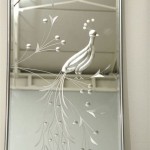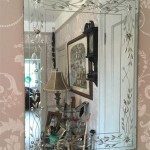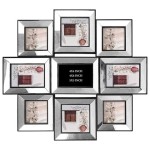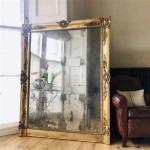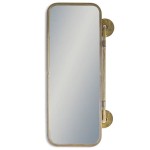Hang Large Mirror No Nails
Hanging a large mirror without nails might seem daunting, but several effective methods offer secure and damage-free solutions. These techniques cater to various wall types and mirror weights, providing flexibility and convenience for renters and homeowners alike.
Adhesive Strips and Hooks
Specialized adhesive strips and hooks designed for mirrors provide a robust and straightforward hanging method. These products utilize advanced adhesive technology to securely bond with both the mirror and the wall surface. Weight capacities vary, so it's crucial to select a product rated to hold the specific weight of the mirror being hung. Before application, ensure the wall is clean and dry for optimal adhesion. Following the manufacturer's instructions is essential for proper installation and to achieve the stated weight capacity.
Many adhesive mirror hangers incorporate a peel-and-stick application process. This simplifies the hanging process considerably, making it a user-friendly option even for those with limited DIY experience. Some products also offer adjustable features, allowing for minor adjustments to the mirror's position after installation for perfect alignment. Be aware that adhesive strips and hooks are typically intended for smooth surfaces like painted walls, tiles, and glass. Textured walls or wallpapered surfaces might require specific adhesive solutions or alternative hanging methods.
Mirror Mounting Systems
Mirror mounting systems offer a more permanent, albeit still nail-free, solution for hanging large, heavy mirrors. These systems typically include brackets, clips, or channels that securely grip the mirror's edges. Instead of nails, these systems often rely on adhesive or strong suction cups for attachment to the wall. The brackets or clips are strategically positioned on the back of the mirror and then affixed to the wall-mounted components.
Mirror mounting systems provide excellent stability and support, especially for oversized or particularly heavy mirrors. They distribute the weight evenly, reducing the risk of the mirror slipping or falling. The use of clips or channels also offers a degree of adjustability, allowing for precise alignment during installation. Similar to adhesive strips, ensure the wall surface is clean and appropriate for the chosen mounting system's adhesive or suction method.
Heavy-Duty Velcro
Industrial-strength Velcro provides another surprisingly effective method for hanging large mirrors without nails. While standard Velcro may not be sufficient for heavier mirrors, heavy-duty versions offer significantly higher weight capacities. This method involves attaching one side of the Velcro to the back of the mirror and the other to the wall. Ensuring adequate surface area contact between the Velcro strips and both surfaces is critical for maximizing the holding power.
This method is particularly well-suited for situations where a temporary hanging solution is desired, as the Velcro can be removed without leaving residue or damaging the wall. However, as with other adhesive methods, it's vital to select a Velcro product specifically designed for heavy-duty applications and appropriate for the weight of the mirror. It's also advisable to test the Velcro's holding strength in an inconspicuous area before committing to hanging the mirror in its intended location.
Wire or Rope Hanging Systems
For a more decorative approach, consider using a wire or rope hanging system. While this method often requires small hooks or anchors, it can still minimize wall damage compared to traditional nail hanging. The wire or rope is attached to D-rings or other hardware secured to the back of the mirror. These are then hung from hooks or anchors installed in the wall.
This method allows for flexibility in hanging height and positioning, and the visible wire or rope can add a stylistic element to the room's decor. When choosing this method, select a wire or rope with adequate weight capacity and ensure the hooks or anchors are appropriate for the wall type and the weight of the mirror. This method is particularly suitable for scenarios where a more decorative or adjustable hanging solution is desired.
Considerations for Different Wall Types
Different wall types require specific considerations when hanging mirrors without nails. Drywall, plaster, brick, and tile each present unique challenges and limitations. Certain adhesive solutions may be more suitable for some surfaces than others. For brick or concrete walls, specialized anchors might be necessary even for nail-free hanging systems. Researching the specific requirements for the intended wall type will ensure a secure and damage-free installation.
For renters, prioritizing removable and damage-free methods is crucial. Adhesive strips, Velcro, and certain mounting systems offer excellent options for temporary installations. It's always advisable to consult with landlords before making any modifications to the walls, even when using nail-free hanging methods. Understanding the building's regulations and seeking permission ensures compliance and avoids potential issues.

3 Simple Ways To Hang A Mirror On Wall Without Nails Wikihow

3 Simple Ways To Hang A Mirror On Wall Without Nails Wikihow

How To Hang A Heavy Mirror In 5 Simple Steps

Hang A Mirror Without Nails Diyer S Guide To Great Results

How To Hang A Bathroom Mirror Without Nails S Or Drilling Velcro Brand

3 Simple Ways To Hang A Mirror On Wall Without Nails Wikihow

3 Simple Ways To Hang A Mirror On Wall Without Nails Wikihow

How To Hang A Mirror On Wall Without Nails Guide For All Diyers

How To Hang Heavy Mirrors Frames Without Nails 3m

How To Hang A Heavy Mirror At Home

